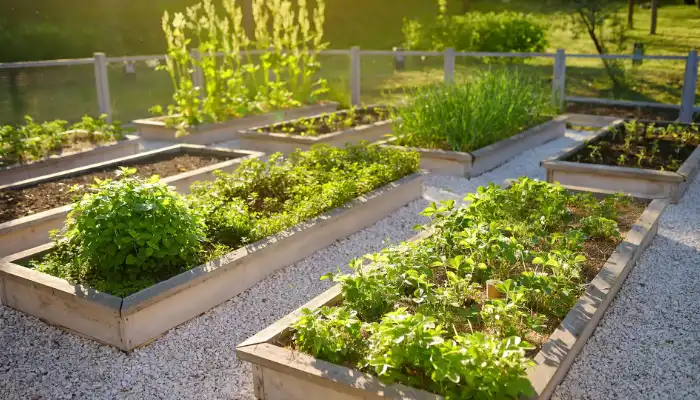Imagine a garden teeming with life – vibrant flowers attracting pollinators, healthy vegetables flourishing without harmful chemicals, and a sense of harmony existing between humans and nature. This isn’t just a utopian ideal; it’s the essence of sustainable gardening.

What is a Sustainable Garden?
A sustainable garden prioritizes practices that minimize environmental impact while maximizing the long-term health of your local ecosystem. It’s about nurturing a vibrant space that provides beauty, food, and enjoyment while conserving resources and fostering biodiversity.
Why Go Green? The Benefits of Sustainable Gardening
Sustainable gardening practices offer a multitude of benefits, enriching not only your garden but also your life and the environment:
- Environmental Responsibility: By minimizing water usage, reducing waste, and promoting healthy soil, sustainable gardening contributes to a more sustainable future for our planet.
- Healthier Produce: You’ll enjoy the satisfaction of cultivating your own chemical-free fruits and vegetables, ensuring a safe and healthy harvest for your family.
- A Haven for Wildlife: Sustainable gardens create a haven for pollinators like bees and butterflies, promoting biodiversity and fostering a healthy ecosystem.
- Reduced Costs: Water conservation techniques and natural pest control methods can significantly reduce your gardening expenses.
- Enhanced Well-being: The act of nurturing a garden provides therapeutic benefits, promoting relaxation and a sense of connection with nature.
Understanding the Core Principles
Sustainable gardening is rooted in a few key principles:
- Conservation of Resources: Minimize water usage, utilize renewable resources like rainwater, and prioritize organic gardening practices.
- Biodiversity Preservation: Create a habitat for beneficial insects, birds, and other wildlife to promote a healthy ecosystem.
- Waste Reduction: Compost food scraps and yard waste to create nutrient-rich fertilizer, minimizing reliance on landfills.
- Soil Health Maintenance: Nourish your soil with organic matter, promoting healthy plant growth and reducing reliance on chemical fertilizers.
Planning Your Sustainable Paradise
Before diving headfirst into planting, some groundwork is essential:
1. Assess Your Space and Resources:
- Consider the amount of sunlight different areas receive throughout the day.
- Evaluate your available water resources and drainage capabilities.
- Determine your budget for plants, seeds, tools, and potential infrastructure.
2. Choose Suitable Plants:
- Opt for native plants that thrive in your climate and require minimal water.
- Select a diverse range of plants to attract beneficial insects and pollinators.
- Consider incorporating drought-resistant varieties to minimize water needs.
3. Design for Efficiency:
- Group plants with similar water requirements together for better irrigation management.
- Plan walkways and access points for easy maintenance and harvesting.
- Utilize vertical gardening techniques to maximize space in smaller areas.
4. Eco-Friendly Layout:
- Integrate compost bins and rain barrels into your design for convenient waste management and water conservation.
- Choose recycled or sustainably sourced materials for raised beds, pathways, and garden structures.
- Position your garden to capture rainwater runoff and utilize natural drainage solutions.
Implementing Sustainable Practices
Now comes the fun part – putting your plan into action! Here are some key strategies for sustainable gardening:
A. Water Conservation Techniques
- Rainwater Harvesting: Install rain barrels to collect rainwater for irrigation, reducing reliance on tap water.
- Drip Irrigation Systems: Utilize drip irrigation systems that deliver water directly to plant roots, minimizing evaporation and water waste.
- Mulching Magic: Apply a layer of mulch around your plants to retain moisture in the soil, reducing the need for frequent watering.
Table 1: Benefits of Mulching
| Benefit | Description |
|---|---|
| Moisture Retention | Reduces evaporation and helps retain moisture in the soil. |
| Weed Suppression | Suppresses weed growth, minimizing competition for water and nutrients. |
| Soil Temperature Regulation | Moderates soil temperature, protecting plant roots from extreme hot and cold. |
| Erosion Control | Prevents soil erosion from wind and heavy rain. |
B. Soil Health Management
- Composting Powerhouse: Compost kitchen scraps, yard waste, and other organic materials to create nutrient-rich fertilizer for your garden, reducing reliance on chemical alternatives.
- Natural Power Boost: Utilize natural fertilizers and soil amendments like compost tea, worm castings, and organic manure to nourish your soil and promote healthy plant growth.
- Crop Rotation and Companions: Implement crop rotation to prevent soil depletion and companion planting to deter pests naturally and attract beneficial insects.
C. Pest and Disease Management
- Beneficial Bug Brigade: Attract beneficial insects like ladybugs, lacewings, and praying mantises that can help control harmful pests naturally.
- Companion Planting Power: Plant certain herbs and flowers alongside your vegetables to deter pests naturally and attract beneficial insects. Here are some examples:
- Marigolds: These vibrant flowers deter nematodes, aphids, and whiteflies with their strong scent.
- Nasturtiums: These fast-growing flowers act as trap crops, attracting aphids away from your prized vegetables.
- Mint: The strong aroma of mint repels ants, aphids, and even some rodents. However, be mindful of the mint’s invasive tendencies; consider planting it in pots.
- Lavender: This fragrant herb attracts pollinators like bees and butterflies while deterring flies and mosquitos.
- Dill: Dill attracts beneficial insects like hoverflies, which prey on aphids, while also repelling some caterpillars.
- Natural Remedies and Biological Controls: Opt for natural remedies and biological controls instead of harsh chemical pesticides. Here are some options:
- Insecticidal Soap Spray: Made from fatty acids, insecticidal soap spray effectively controls soft-bodied insects like aphids and mealybugs without harming beneficial insects or pollinators.
- Neem Oil Spray: Neem oil is a natural fungicide and insecticide derived from the neem tree. It disrupts the life cycle of many pests and can also help prevent fungal diseases.
- Diatomaceous Earth: This naturally occurring powder dehydrates insects with its abrasive texture, effectively controlling crawling pests like slugs and beetles.
The Ever-Watchful Gardener: Monitoring and Maintaining
A sustainable garden thrives on consistent care, but not at the expense of the environment. Here’s how to ensure your garden flourishes naturally:
- Observe and Adapt: Become a keen observer of your garden. Identify areas that need more or less sunlight, monitor plant growth patterns, and be proactive in addressing potential issues.
- Sustainable Maintenance Techniques:
- Pruning and Weeding with Care: Proper pruning techniques encourage healthy plant growth and shape. Similarly, hand weeding eliminates unwanted competition for water and nutrients without resorting to harmful herbicides.
- The Magic of Mulch and Compost: Mulch acts as a natural blanket, retaining moisture, suppressing weeds, and regulating soil temperature. Composting kitchen scraps and yard waste provides nutrient-rich fertilizer, reducing reliance on chemical alternatives.
- Natural Pest and Disease Management: Attract beneficial insects like ladybugs and lacewings that naturally control harmful pests. Encourage a diverse range of plants – some may deter pests simply by their presence! Utilize natural remedies like insecticidal soap or neem oil for targeted pest control when necessary.
Maximizing Sustainability: Responsible Choices
Every decision you make in your garden contributes to its overall sustainability. Here are some key considerations:
- Eco-Friendly Materials and Tools: Opt for recycled or sustainably sourced materials for raised beds, pathways, and garden structures. Choose tools made from recycled materials or with a long lifespan to minimize waste.
- Supporting Local Ecosystems: Select native plants that are well-suited to your climate and require minimal water. This not only reduces your water needs but also creates a haven for local pollinators like bees and butterflies.
- Ditching the Chemicals: Avoid using harmful chemical pesticides and fertilizers. Explore natural alternatives like insecticidal soap, neem oil, or organic pest control methods for a healthier garden and environment.
- Energy-Conscious Practices: Minimize the use of power tools and consider hand tools for tasks like weeding or pruning. Capture rainwater for irrigation instead of relying solely on tap water.
Spreading the Seeds of Sustainability: Sharing and Educating
Sustainable gardening isn’t just about your own backyard; it’s about fostering a collective responsibility for the environment. Here’s how to share your knowledge and inspire others:
- Engage with Your Community: Connect with local gardening clubs, participate in community garden projects, or organize workshops to share your sustainable gardening knowledge.
- Resource Sharing: Offer seeds or cuttings from your successful plants, swap gardening tips with neighbors, and share information about sustainable practices online or through local forums.
- Inspiring Action: Lead by example! Let your thriving, sustainable garden be a testament to the power of these practices. Encourage others to embrace eco-friendly gardening and contribute to a greener future.
Conclusion
Sustainable gardening is a journey, not a destination. By embracing the practices outlined above, you can create a beautiful garden that thrives in harmony with nature. Every effort, from choosing native plants to composting kitchen scraps, contributes to a more sustainable future. So, take action, start your sustainable gardening journey today, and inspire others to join you. Together, we can cultivate a greener tomorrow, one garden at a time.


